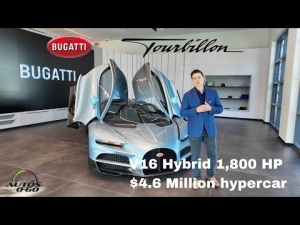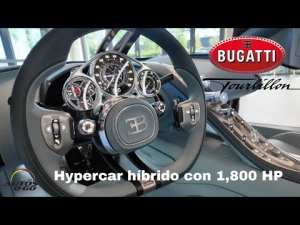Doug DeMuro Geeks out Over the ‘Forgotten’ Bugatti EB110
Success stories aren’t guaranteed in the world of supercars. And that even applies to a brand as well-known as Bugatti. It’s only because Volkswagen resurrected it that the world has cars like the eight-figure La Voiture Noire one-off. However, VW wasn’t the first entity to try and bring Bugatti back from the dead. There was an earlier attempt that birthed a lesser-known supercar: the Bugatti EB110. And recently, Doug DeMuro got behind the wheel of one.
The Veyron of the ‘90s, the Bugatti EB110 can match the McLaren F1’s history, engineering, and performance
Although pre-war models like the Type 35 earned Bugatti an international relationship, the French marque didn’t survive long after WWII. After founder Ettore Bugatti died in 1947, the brand itself closed in 1952. And for decades, it stayed that way.
But in 1987, Italian industrialist Romano Artioli bought the rights to the Bugatti name. The following year, he started building a state-of-the-art factory in the outskirts of Modena, Italy. It was practically within earshot of Ferrari’s and Lamborghini’s factories, Hagerty notes. And pulling from the local design, engineering, and manufacturing expertise, Artioli began working on a supercar. That supercar was the 1991 Bugatti EB110.
Calling the Bugatti EB110 a supercar might be selling it slightly short. MotorTrend and Autoweek muse that it’s arguably one of, if not the first hypercar. Automobile holds it in equal regard to the McLaren F1. And considering what the EB110 offered in the ‘90s, that’s not hyperbole.

For its time, the Bugatti EB110 was highly advanced; but, like the F1, it was also old-school. Like the F1, it has a carbon-fiber chassis and a six-speed manual. But unlike the F1, it has aluminum body panels, an electronically-rising rear wing, all-wheel drive, and a completely, from-the-ground-up bespoke engine, The Drive notes. It’s a mid-mounted 3.5-liter quad-turbocharged V12 that, in the EB110 GT, makes 560 hp and 450 lb-ft of torque. That’s enough to let the Bugatti EB110 go 0-60 mph in under 3.6 seconds and top out at 209 mph, MT says.
The later Bugatti EB110 Super Sport, aka the ‘EB110 SS,’ though, was even faster. Its V12 makes 611 hp and 479 lb-ft of torque, The Drive says. And thanks to weight-savings measures like Kevlar body panels, the EB110 SS is roughly 300 pounds lighter than the GT, Hagerty reports. That meant a 0-60 mph time of 3.26 seconds, and a 221-mph top speed.
Calling the Bugatti EB110 a 1990s Veyron, then, is appropriate. Because for a time, it was one of the fastest cars in the world.
Let Doug DeMuro show you just how quirky a Bugatti EB110 GT is
The Bugatti EB110, though, isn’t just fast. As Doug DeMuro explains in the video above, it’s also as quirky as a ‘90s supercar can be.
For example, the latch for the scissor door isn’t where the ‘handle’ is; instead, it’s located below a mid-level panel crease. And if you want to get out of the EB110, the doors unlatch electronically. Though there are emergency mechanical releases if the battery goes flat. Also, the only power-adjustable features on the EB110’s seats are the backrests and lumbar support. And getting back to that crease in the panels, that also limits how much the power windows go down. Further limiting fresh air entry is the fact that only a small portion of the window glass moves.

Although the Bugatti EB110 has a bespoke engine, some of its components were more ‘garden-variety.’ Its gauges and steering-wheel stalks, Doug DeMuro explains, are identical to those found in Lamborghinis from this period. It’s a similar story with the HVAC controls. Speaking of controls, some of the ones in the Bugatti EB110, are mounted on the ceiling. That’s also where you’ll find the ABS warning light and maneuverable map light.
The fuel door release is also mounted on the ceiling. However, it only opens the passenger’s side fuel door. That’s right, Bugatti EB110 has two fuel doors because it has two fuel tanks. The supercar doesn’t have two windshield wipers, though. Instead, it has three separate blades mounted on one arm.
Being a supercar/hypercar, the Bugatti EB110 isn’t exactly practical. As Doug DeMuro shows in his video, the largest storage space is the glovebox. And the seating position is a bit tight, if not exceedingly so. However, the EB110 “feels surprisingly well put together,” DeMuro says, especially given that it’s a ‘90s car from an orphaned brand. The clutch is also remarkably light and the shifter is “pretty easy and nice to use.” DeMuro found it surprisingly civilized overall, especially compared to cars like the Diablo and Countach.
It’s a rare supercar worthy of its badge—and now worth millions
That civility and performance, though, came with a high price tag; in 1991, the EB110 cost the equivalent of $692,000. And it didn’t help that the Bugatti EB110 debuted right before an economic downturn. There are also rumors that some of Bugatti’s Italian competitors may have also played a role in its downfall, Autoweek muses. Regardless, shortly after EB110 production ended, the company went bankrupt.
After the bankruptcy, German firm Dauer Sportwagen bought the remaining components and unfinished cars and made some ‘continuation’ EB110s, Automobile explains. But only 139 EB110s left the Modena factory. Of these, 30 are EB110 SS models. That makes the latter rarer than a McLaren F1, if not quite as valuable.
That being said, a Bugatti EB110, especially an SS model, is still an expensive car. And these days it’s even more expensive. Today, a pristine EB110 SS can easily go for $2 million, Hagerty reports. And even ‘lesser’ examples cost close to $1 million. Bugatti even offers a factory restoration service for it.
It seems, therefore, that the Bugatti EB110 might not be forgotten for much longer.
Follow more updates from MotorBiscuit on our Facebook page.
RELATED: Take a Tour of an $8 Million Bugatti Divo Hypercar
The post Doug DeMuro Geeks out Over the ‘Forgotten’ Bugatti EB110 appeared first on MotorBiscuit.






